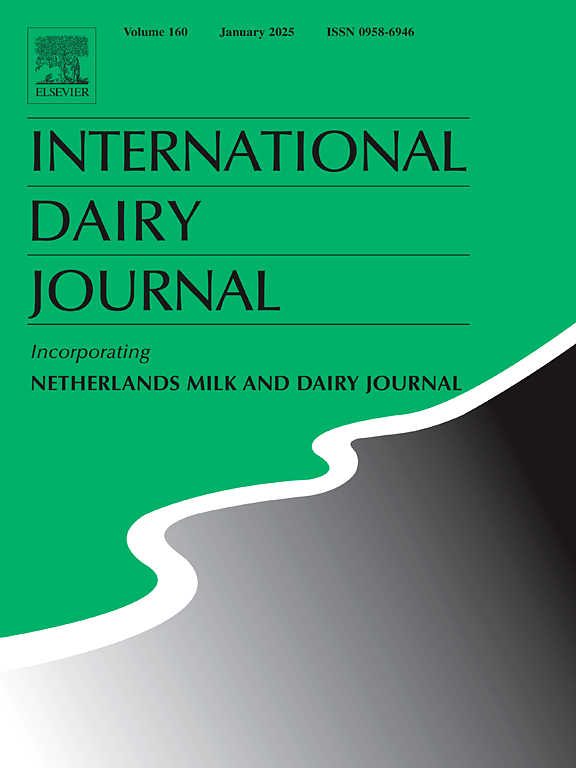基于CoFe-MOFs@MWCNTs修饰电极的无标记电化学免疫传感器快速检测牛奶中的沙门氏菌
IF 3.4
3区 农林科学
Q2 FOOD SCIENCE & TECHNOLOGY
引用次数: 0
摘要
电化学传感器在微生物的快速检测中表现出明显的优势。在这项研究中,我们设计了一种利用CoFe-MOFs@MWCNTs复合修饰电极的无标签电化学免疫传感器,用于牛奶中沙门氏菌的特异性检测。将CoFe-MOFs@MWCNTs复合材料整合到电极表面,有效地增强了电流响应并提供了丰富的活性位点,随后通过电沉积的AuNPs进行信号放大和抗体偶联。通过扫描电子显微镜对CoFe-MOFs@MWCNTs复合材料的微观结构特征进行了细致的研究,同时利用能量色散x射线能谱和傅里叶变换红外光谱对其元素组成和化学结构进行了深入的分析。优化实验参数后,该传感器对沙门氏菌的线性检测范围为1.04 × 104 ~ 1.04 × 108 CFU mL - 1,检出限(LOD)为2.89 × 103 CFU mL - 1,具有优异的灵敏度、特异性和稳定性。在本研究中,我们将电化学方法的灵敏度和免疫反应的特异性与多种纳米材料的实验信号放大相结合,实现了沙门氏菌的灵敏检测。这种创新的传感器有望检测牛奶中的沙门氏菌,并提出了一种监测食源性病原体的新方法。本文章由计算机程序翻译,如有差异,请以英文原文为准。

Rapid detection of Salmonella in milk by a label-free electrochemical immunosensor based on CoFe-MOFs@MWCNTs modified electrode
Electrochemical sensors exhibit distinct advantages over alternative sensor modalities in the swift detection of microorganisms. In this study, we devised a label-free electrochemical immunosensor utilizing CoFe-MOFs@MWCNTs composite-modified electrodes for the specific detection of Salmonella in milk. The integration of CoFe-MOFs@MWCNTs composites onto the electrode surface effectively enhanced the current response and furnished an abundance of active sites, subsequently augmented by electrodeposited AuNPs for signal amplification and antibody conjugation. The microstructural characteristics of the CoFe-MOFs@MWCNTs composite were meticulously examined via scanning electron microscopy, while its elemental composition and chemical structure were thoroughly analyzed using energy-dispersive X-ray spectroscopy and Fourier transform infrared spectroscopy, respectively. Upon optimization of the experimental parameters, the sensor demonstrated exceptional sensitivity, specificity, and stability, exhibiting a linear detection range spanning from 1.04 × 104 to 1.04 × 108 CFU mL−1 for Salmonella, with a limit of detection (LOD) of 2.89 × 103 CFU mL−1. In this study, we combined the sensitivity of electrochemical methods and the specificity of immunological reactions with experimental signal amplification from a variety of nanomaterials to achieve sensitive detection of Salmonella. This innovative sensor holds promise for the detection of Salmonella in cow's milk and presents a novel approach for monitoring foodborne pathogens.
求助全文
通过发布文献求助,成功后即可免费获取论文全文。
去求助
来源期刊

International Dairy Journal
工程技术-食品科技
CiteScore
6.50
自引率
9.70%
发文量
200
审稿时长
49 days
期刊介绍:
The International Dairy Journal publishes significant advancements in dairy science and technology in the form of research articles and critical reviews that are of relevance to the broader international dairy community. Within this scope, research on the science and technology of milk and dairy products and the nutritional and health aspects of dairy foods are included; the journal pays particular attention to applied research and its interface with the dairy industry.
The journal''s coverage includes the following, where directly applicable to dairy science and technology:
• Chemistry and physico-chemical properties of milk constituents
• Microbiology, food safety, enzymology, biotechnology
• Processing and engineering
• Emulsion science, food structure, and texture
• Raw material quality and effect on relevant products
• Flavour and off-flavour development
• Technological functionality and applications of dairy ingredients
• Sensory and consumer sciences
• Nutrition and substantiation of human health implications of milk components or dairy products
International Dairy Journal does not publish papers related to milk production, animal health and other aspects of on-farm milk production unless there is a clear relationship to dairy technology, human health or final product quality.
 求助内容:
求助内容: 应助结果提醒方式:
应助结果提醒方式:


